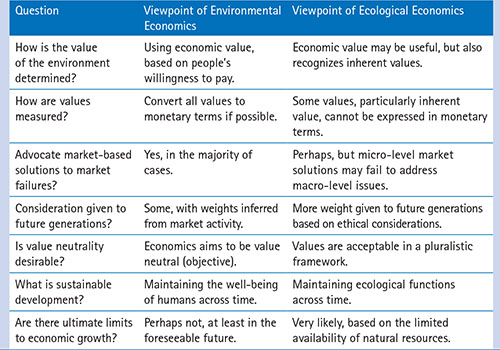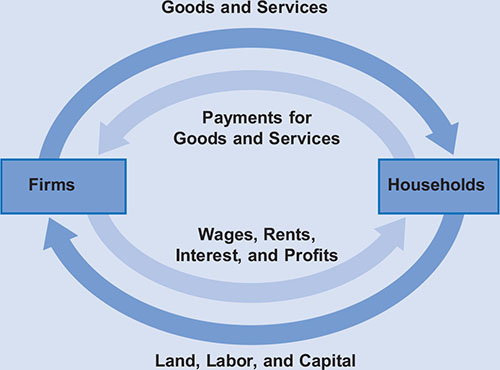I.
Economic Analysis of Environmental Issues
A. Introduction: The Economy and
the Environment
- Important events in modern environmental
history:
|
1962: |
The publication of Rachel Carson’s Silent
Spring, widely recognized
as the catalyst of the modern environmental movement, details
the dangers posed by excessive pesticide use. |
|
1964: |
The passage of the Wilderness Act in the United States, which
protects public lands that are “untrammeled by man, where man
himself is a visitor who does not remain.” |
|
1969: |
The Cuyahoga River in Ohio is so polluted by oil and other
chemicals that it catches on fire, prompting widespread concern
about water pollution and eventually the passage of the Clean
Water Act in 1972. |
|
1970: |
The creation of the Environmental Protection Agency by President
Richard Nixon. Also, over 20 million participate in the first
Earth Day on April 22. |
|
1972: |
The creation of the United Nation’s Environment Programme
(UNEP), headquartered in Nairobi, Kenya. |
|
1979: |
The partial meltdown of the Three Mile Island nuclear reactor in
Pennsylvania raises concerns about the safety of nuclear energy.
These concerns are exacerbated by the explosion of the Chernobyl
reactor in the Soviet Union in 1986. |
|
1987: |
The United Nations’ Brundtland Commission publishes “Our Common
Future,” which defines sustainable development as “development
that meets the needs of the present without compromising the
ability of future generations to meet their own needs.” |
|
1992: |
The Rio Declaration on Environment and Development recognizes
“the integral and independent nature of the Earth, our home,”
and lists 27 principles of sustainable development including
reducing global inequities, international cooperation, and the
promotion of an economic system that addresses environmental
problems. |
|
1997: |
The Kyoto Protocol is negotiated, the first international treaty
that commits ratifying nations to reduce their greenhouse gas
emissions. Although rejected by the United States, the treaty
was ratified by 191 nations and entered into force in 2005. |
|
2002: |
The Johannesburg Declaration on Sustainable Development
recognized that “humanity is at a crossroads” and there exists
“a collective responsibility to advance and strengthen the . . .
pillars of sustainable development—economic development, social
development, and environmental protection.” |
|
2009: |
Nations participating in climate change talks in Copenhagen
agree that actions should be implemented to limit eventual
global warming to no more than 2°C, though no binding
commitments are made to reduce emissions. |
|
2015: |
The Paris Agreement on climate change, approved by 195
countries, calls for a “global peaking of greenhouse gas
emissions as soon as possible” with a goal of “holding the
increase in global average temperature to well below 2°C above
pre-industrial levels.” Over 150 countries submit plans to limit
their greenhouse gas emissions. |
1. Economic approaches to the environment
a. Environmental economics
(1)
The theory of environmental externalities
(2)
The optimal management of common property and public goods
(3)
The optimal management of natural resources over time
(4)
The economic valuation of environmental goods and services
.
b. Ecological economics
(1)
The economic system is a subset of the broader ecological system
(2)
Sustainability should be defined according to ecological, rather than
economic, criteria
(3)
It is essential to rely upon a range of academic disciplines and
perspectives, in addition to economics, to provide insight into
environmental issues

2. Circular flow model
a. Standard

b. Expanded

3. Economic growth
.
a. Standard growth model
GDP = population * per capita GDP
GDP growth rate = population growth rate + per
capita GDP growth rate
Per capita GDP growth rate = GDP growth rate -
population growth rate
.
.
b. Ecological economics
(1) Energy supply
(2) Supplies of land and natural resources
(natural capital)
(3) Absorptive capacity of the environment
- the ability of the environment to absorb and render harmless waste
products
.
4. Environmental trends
a. Atmosphere
b. Land
c. Water
d. Biodiversity
e. Chemicals and waste
.
5. Optimists and pessimists
a. Pessimists
-
Thomas Malthus (1798) - Essay
on the Principle of Population, Jay Forrester (1972) - The
Limits to Growth
-
Society will run
out of resources
-
Sudden
collapse of economic system, decreased food
production, massive deaths ("overshoot
and collapse")
-
Negative environmental consequences - climate
change, species loss, pollution, deforestation, depletion of water,
buildup of toxic waste
.
b. Optimists
-
Julian Simon
(1981) - The
Ultimate Resource
-
Standard of
living rising
-
Economic and
political systems respond to scarcity
-
Higher income
=> increased demand for environmental
quality, increased ability to pay
-
Knowledge and
technology can
overcome limits
.
6. Sustainable development
a. Population
.
b. Agriculture
-
Modern techniques can have negative
environmental consequences - chemical fertilizers, pesticides, heavy
water use, mechanization requiring fossil fuels
.
c. Energy
d. Natural resources
.
|


